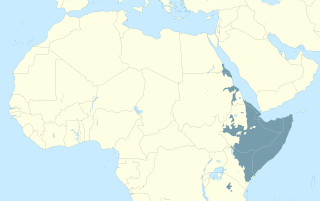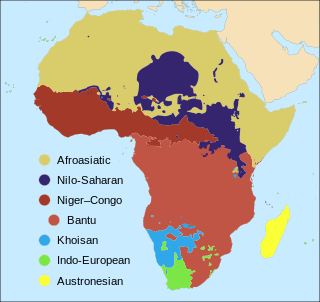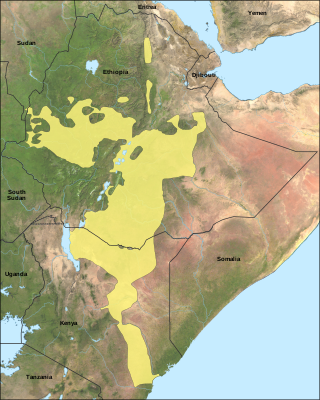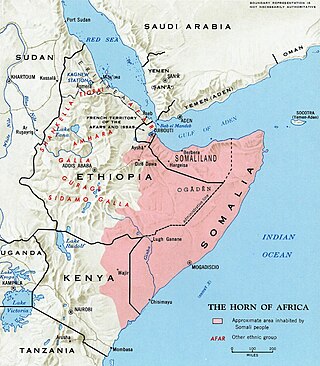Related Research Articles

The Cushitic languages are a branch of the Afroasiatic language family. They are spoken primarily in the Horn of Africa, with minorities speaking Cushitic languages to the north in Egypt and Sudan, and to the south in Kenya and Tanzania. As of 2012, the Cushitic languages with over one million speakers were Oromo, Somali, Beja, Afar, Hadiyya, Kambaata, and Sidama.

The number of languages natively spoken in Africa is variously estimated at between 1,250 and 2,100, and by some counts at over 3,000. Nigeria alone has over 500 languages, one of the greatest concentrations of linguistic diversity in the world. The languages of Africa belong to many distinct language families, among which the largest are:

The Omotic languages are a group of languages spoken in southwestern Ethiopia, in the Omo River region and southeastern Sudan in Blue Nile State. The Geʽez script is used to write some of the Omotic languages, the Latin script for some others. They are fairly agglutinative and have complex tonal systems. The languages have around 7.9 million speakers. The group is generally classified as belonging to the Afroasiatic language family, but this is disputed by some linguists.

Oromo, historically also called Galla, is an Afroasiatic language that belongs to the Cushitic branch. It is native to the Ethiopian state of Oromia and Northern Kenya and is spoken predominantly by the Oromo people and neighboring ethnic groups in the Horn of Africa. It is used as a lingua franca particularly in the Oromia Region and northeastern Kenya.
Afar is an Afroasiatic language belonging to the Cushitic branch. It is spoken by the Afar people inhabiting Djibouti, Eritrea and Ethiopia.

Somali is an Afroasiatic language belonging to the Cushitic branch. It is spoken primarily in Greater Somalia, and by the Somali diaspora as a mother tongue. Somali is an official language in both Somalia and Ethiopia, and serves as a national language in Djibouti, it is also a recognised minority language in Kenya. The Somali language is officially written with the Latin alphabet although the Arabic script and several Somali scripts like Osmanya, Kaddare and the Borama script are informally used.
Lowland East Cushitic is a group of roughly two dozen diverse languages of the Cushitic branch of the Afro-Asiatic family. Its largest representatives are Oromo and Somali.
Dahalo is an endangered Cushitic language spoken by around 500–600 Dahalo people on the coast of Kenya, near the mouth of the Tana River. Dahalo is unusual among the world's languages in using all four airstream mechanisms found in human language: clicks, implosives, ejectives, and pulmonic consonants.
Waaq is the name for the sky God in several Cushitic languages, including the Oromo and Somali languages.
Kenya is a multilingual country. The two official languages of Kenya, Swahili and English are widely spoken as lingua francas; however, including second-language speakers, Swahili is more widely spoken than English. Swahili is a Bantu language native to East Africa and English is inherited from British colonial rule.

The languages of Ethiopia include the official languages of Ethiopia, its national and regional languages, and a large number of minority languages, as well as foreign languages.

Mai-Mai, commonly spelled Maay Maay, is a dialect of the Somali language of the Cushitic branch of the Afro-Asiatic family. It is mainly spoken in Somalia and adjacent parts of Ethiopia and Kenya. In Somalia, it is spoken in South West state, Jubaland state, and Banadir. It is one of the dialects of the Somali language.
Southern Oromo, or Borana, is a variety of Oromo spoken in southern Ethiopia and northern Kenya by the Borana people. Günther Schlee also notes that it is the native language of a number of related peoples, such as the Sakuye.
Baiso or Bayso is an Afro-Asiatic, more specifically a Lowland East Cushitic language belonging to the Omo-Tana subgroup, and is spoken in Ethiopia, in the region around Lake Abaya.

Aweer (Aweera), also known as Boni, is a Cushitic language of Eastern Kenya. The Aweer people, known by the arguably derogatory exonym "Boni," are historically a hunter-gatherer people, traditionally subsisting on hunting, gathering, and collecting honey. Their ancestral lands range along the Kenyan coast from the Lamu and Ijara Districts into Southern Somalia's Badaade District.
The Somali languages form a group that are part of the Afro-Asiatic language family. They are spoken as a mother tongue by ethnic Somalis in Horn of Africa and the Somali diaspora. Even with linguistic differences, Somalis collectively view themselves as speaking dialects of a common language.
Garre is a Somali language spoken by the Garre who reside in southern Somalia, Ethiopia and northern Kenya. It belongs to the family's Cushitic branch, and had an estimated 50,000 speakers in Somalia in 1992, 57,500 in 2006 and 86,000 in 2020. The total number of speakers in Kenya and Somalia was estimated at 685,600 in 2019. Garre is in the Digil classification of Somali dialects. Garre language is readily intelligible to Digil speakers, as it has some affinity with Af-Maay and Af-Boon.
Jiiddu is a Somali language spoken by the Jiiddu sub-clan of the Dir, a Somali clan inhabiting southern Somalia. It currently has an estimated 34,000 speakers, concentrated in the Lower Shabeelle, Bay and Middle Juba regions.
The Hill Nubian languages, also called Kordofan Nubian, are a dialect continuum of Nubian languages spoken by the Hill Nubians in the northern Nuba Mountains of Sudan.
Girirra also called Gariire is a Cushitic language of Ethiopia. It has extensive borrowing from Somali. Although not mutually intelligible with Somali, it is estimated that around 70% of the Garirra language is made up of Somali loan words. There has not been many studies on the language itself and is often grouped into a small umbrella of the Macro-Somali language family including relatives like: Rendille, Boni, Bayso, and the two dialects of Somali, being Af-Maay, and Af-Maxaa.
References
- Lamberti, Marcello (1984). The Linguistic Situation in the Somali Democratic Republic. Proceedings of the Second International Congress of Somali Studies. Volume I. Linguistics and Literature. Hamburg: Helmut Buske. pp. 191–193.